Andrew Richardson[1]
‘Myths and reality about a small battle on the Western Front in 1918: FitzSimons and Dando-Collins on Hamel’, Honest History, 4 July 2018
Andrew Richardson reviews Peter FitzSimons’ Monash’s Masterpiece: The Battle of Le Hamel and the 93 Minutes that Changed the World and Stephen Dando-Collins’ Heroes of Hamel: The Australians and Americans whose WWI Victory Changed Modern Warfare.
***
Some books grow the myth rather than the reality; here are two of them. Today is the centenary of the Battle of Hamel and Peter FitzSimons and Stephen Dando-Collins have produced for the occasion highly readable books to target the mass market. Unfortunately, however, the interpretations in both books are not always supported by evidence.
 Peter FitzSimons’ Monash’s Masterpiece is a substantial book. While the author had pledged that his book on Villers-Bretonneux would be his last on the Great War, he says of Hamel, ‘I knew I had to do the book, and sooner rather than later … It is simply not right that such a battle, such a monumental feat, does not resonate with Australians 100 years later (p. vii).’ The battle does, in fact, already resonate with military historians, but FitzSimons has sought, in his own inimitable style, to give it a wider audience.
Peter FitzSimons’ Monash’s Masterpiece is a substantial book. While the author had pledged that his book on Villers-Bretonneux would be his last on the Great War, he says of Hamel, ‘I knew I had to do the book, and sooner rather than later … It is simply not right that such a battle, such a monumental feat, does not resonate with Australians 100 years later (p. vii).’ The battle does, in fact, already resonate with military historians, but FitzSimons has sought, in his own inimitable style, to give it a wider audience.
This new book provides the context to the battle, explaining how and why the Australian Corps came to be on the Somme from April 1918. Picking up from where Victory at Villers Bretonneux ended, it gives enough background to understand the human and operational environment of Hamel, including how the American 33rd Division were training with the British Fourth Army, including Monash’s Australians.
FitzSimons seeks to breathe life into his ‘Dramatis Personae’ (his term) by addressing their thoughts and recollections in the present tense. He takes reported speech from its historical context and places it for maximum dramatic effect. Sometimes the context is correct; many times it is not. He tries for a real-time ‘boys own adventure’, somewhere between film script and dramatised documentary. The result is neither; it prioritises form over history.
Hamel has been described as Monash’s single greatest piece of planning and execution, with the battle’s objectives achieved in only 93 minutes. In a war that saw battles measured in days and sometimes weeks, this outcome should be sufficient to show the importance of Hamel. Yet FitzSimons’ sub-title goes much further and proudly states, ‘The Battle of Le Hamel and the 93 Minutes that Changed the World’. The author claims that Monash’s plan for Hamel ‘changed the course of warfare and shortened the war (p. vii)’.
Regrettably, neither claim can be substantiated because neither is true. Hamel was instead a very effective and efficient – but limited – operation that captured a small salient to further bolster the defence of Amiens and enable the planning of a much larger battle (Amiens, 8-12 August). Hamel did not cause the catastrophic political and social ferment in Germany that evaporated its political and national will to continue the war, nor did it develop the tactics and technologies that gave the Allies a crucial advantage. Most of these had been trialed at Cambrai at the end of 1917, albeit in a less refined state.
FitzSimons delivers an Australian-centric, chest-beating, Brit-bashing hero story that trumpets Antipodean achievement. Everything is viewed through the prism of Monash’s (and broader Australian) brilliance, mostly to the detriment of the British and Germans. Monash’s perspective on any matter is usually the position that FitzSimons also adopts, which does not make for a nuanced or objective approach to events. Nor does it allow for any critical discussion of Monash. Perhaps that is part of FitzSimons’ mass appeal.
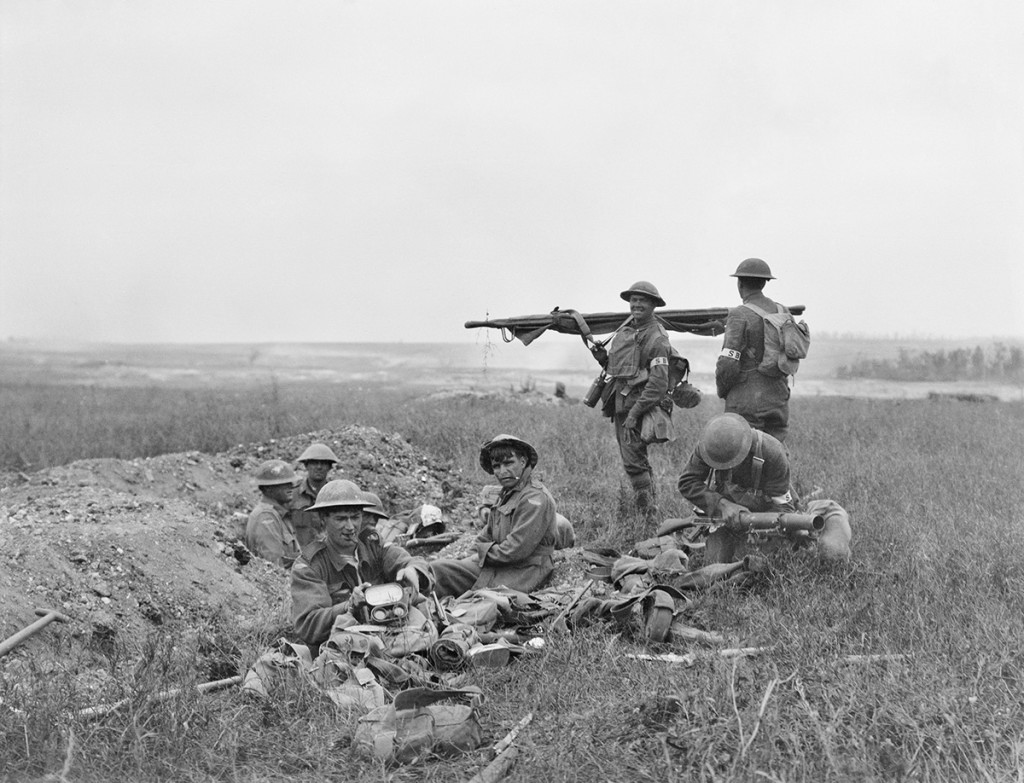 American and Australian stretcher bearers during the Battle of Hamel (AWM E02691)
American and Australian stretcher bearers during the Battle of Hamel (AWM E02691)
Australian ‘big-noting’ permeates this book, but is both unnecessary and a disservice to the achievements of the Australian Imperial Force. FitzSimons implies the pre-battle conference system was a Monash invention (p. 113), though conferences were used by all commanders to varying degrees. British General Gough, for example, ran a conference on 17 July 1916 during the Battle of Pozières.[2] FitzSimons exalts Monash’s intricate knowledge of the battle’s plan (p. 168), as though it was unusual for a commander to know the details of his own operation. FitzSimons claims that Monash ‘had shone from the first’ (p. 20), although this is difficult to support when his performance as 4th Brigade commander on Gallipoli was patchy at best. The author’s agenda seems to be the uncritical embellishment of Monash’s abilities to fit a narrative about the general brilliance of the Battle of Hamel. This is quite unnecessary as Monash’s (and the AIF’s) significant abilities need no boosting.
The errors and omissions in FitzSimons’ book are disappointing and many; they reduce confidence in the book’s accuracy. For example, FitzSimons claims that Bean had never been elected to any position, when he had been elected (defeating Keith Murdoch) in a ballot of the Australian Journalists Association to be the official Australian correspondent to the AIF. He also writes that neither Murdoch nor Bean ‘has ever fired a shot in anger, or led so much as a corporal’s guard in battle’ (p. 165). Yet, Bean showed personal bravery at Cape Helles and was recommended for a Military Cross for helping a wounded man under fire. Later, he was wounded but refused to be medically evacuated. FitzSimons’ attack on Bean’s character omits facts that disprove FitzSimons’ view.
Most astonishingly, FitzSimons claims that the Battle of Hamel was larger than the Battle of Messines in June 1917. He recounts a visit from the British Commander-in-Chief, Field Marshal Sir Douglas Haig, to Monash before Messines in June 1917. Monash gave Haig ‘as comprehensive an overview of all arms of the battle as Haig could possibly hope for, and clearly knew the detail intimately, because he had personally written it … This [Hamel] is exactly like that [Messines], albeit with even more detail, for the much bigger battle’ (pp. 158-59). In fact, Messines was approximately ten times the size of Hamel just in the attacking Allied infantry alone, leaving aside the detonation at Messines of 19 underground mines in support.
FitzSimons also misunderstands the 1918 Spring Offensive (Kaiserschlacht), reducing it to a single operation (Michael, commencing 21 March): ‘For, oh, what a battle the Kaiserschlacht had been, and how well the Australians had done! (p. 2)’. The offensive also included Operations Georgette (9 April), Blücher-Yorck (27 May), Gneisenau (9 June), and Friedensturm (15 July), but FitzSimons does not mention them because they did not involve the Australian Corps. This is a misrepresentation of the entire scope and intent of the Kaiserschlacht battles.
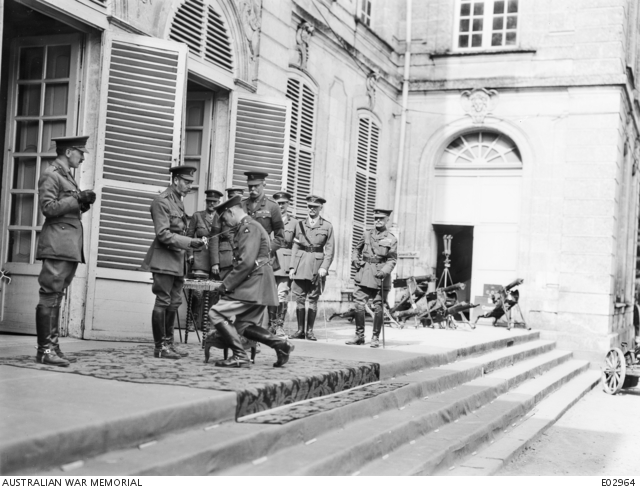 King George V confers Monash’s knighthood (AWM E02964)
King George V confers Monash’s knighthood (AWM E02964)
Further, FitzSimons writes that Monash was knighted on 12 August 1918 by the King (p. 350). In fact, Monash had been awarded a knighthood in the New Year’s Honours List, 1918. The King in August was merely conferring the knighthood on him – tapping him on the shoulder with a sword and shaking his hand – but he had been created a Knight Commander of St Michael and St George (KCMG) and gazetted a Knight Commander of the Order of the Bath (KCB) on 1 January 1918.
Such errors compound the author’s ‘Ocker’ style, which finds its colloquial climax with the bizarre insertion of a joke into the account of Prime Minister Hughes and Navy Minister Cook’s visit to Australian troops at Bussy-lès-Daours on 3 July (p. 178). More important, though, is FitzSimons’ claim that Hamel and the Australian Corps were critical to winning the war. This claim is summarised thus (p. 352):
In no small part due to the exertions of Sir John Monash and his men, and the example they set at Hamel – which was then replicated many times over – the war was over within weeks. Germany sought peace terms from the Allies, and, with the Armistice at 11am on 11 November 1918, the war ended. Bravo, you brave bastards. Lest we forget.
The reality was different. Between Amiens (8 August) and Montbrehain (5 October), Monash pushed the Australian Corps very hard as one of the spearheads of the Fourth Army. Meanwhile, the other four British Armies in northern France and Belgium, and the French and Americans on the rest of the Western Front, launched major offensives that bit deeply into German-held territory.
Due to a mixture of exhaustion and the nearly 34 000 casualties sustained under Monash’s command, the Australian Corps was withdrawn from the fighting over a month before the Armistice. There had been protests – or what Charles Bean described in his diary on 27 September as ‘a regular epidemic of mutinies’ – in around one-sixth of the Australian battalions in France.[3] All these facts are omitted from FitzSimons’ book because they complicate his overstated message about Hamel’s importance and Monash’s role within it.
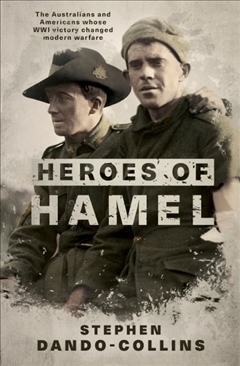 Then there is Stephen Dando-Collins’ work on Hamel. This book has more of an operational focus than FitzSimons. In contrast with the long and at times frustrating backstory in Monash’s Masterpiece, Dando-Collins launches almost straight into the planning of the Hamel operation, bringing a welcome immediacy and battle focus that FitzSimons’ undisciplined and ambling narrative lacks. (Less than one-quarter of FitzSimons’ pages are about the battle.)
Then there is Stephen Dando-Collins’ work on Hamel. This book has more of an operational focus than FitzSimons. In contrast with the long and at times frustrating backstory in Monash’s Masterpiece, Dando-Collins launches almost straight into the planning of the Hamel operation, bringing a welcome immediacy and battle focus that FitzSimons’ undisciplined and ambling narrative lacks. (Less than one-quarter of FitzSimons’ pages are about the battle.)
Heroes of Hamel is broadly accurate in its account of the battle, though it by no means represents the latest historical research. While Dando-Collins is more nuanced in his assessment of British capabilities, he falls into the same trap as FitzSimons of uncritically repeating criticism of the British soldier (pp. 14-15). If such assessments are accepted, it is surprising that the British had any battlefield success. Australian military writing will have matured when popular Great War histories seek to acknowledge the fighting efforts of all combatants, instead of denigrating other forces in comparison with Australian achievements.
Whereas FitzSimons’ treatment of Monash the man is reverential, Dando-Collins allows for feet of clay. While acknowledging Monash’s serious and undoubted ability, Dando-Collins (pp. 10-11) admits Monash’s ‘ego’, arising from his strong self-belief – a characteristic that is abundantly clear from reading Peter Pedersen’s Monash as Military Commander. Dando-Collins also provides thumbnail assessments of the Australian divisional commanders (pp. 11-13), based on Monash’s own observations. Disappointingly though, Monash’s claims (in his book The Australian Victories in France in 1918) to halting the German advance on Amiens are taken at face value: the Australians of the 3rd and 4th Divisions ‘had stepped in and changed the course of the war’ (Dando-Collins, p. 16). This is a simplistic overstatement.
Dando-Collins regurgitates stale myths about Hamel, claiming it was the first use of a surprise attack that integrated infantry, artillery, tanks and air power (p. 17). Yet Cambrai seven months earlier had seen these same techniques employed in a combined attack, fought by Bean’s ‘extraordinarily guileless’ and ‘humble-minded’ British soldier (p. 14) no less. The author also claims that no United States combat troops had been involved in an offensive action in France prior to Hamel (pp. 27, 30), yet the American Expeditionary Force had already taken part in offensive actions at the Battles of Cantigny (28 May 1918) and Belleau Wood (1-26 June 1918). He also claims that Hamel was the first time that air-drops of machine gun ammunition were attempted during the war (p. 102), though the Allies picked up this idea from captured German documents.
Dando-Collins also makes assumptions without evidence. There is, for example, the alleged ambivalence of Allied General Headquarters about the value of tanks (p. 19), despite the encouraging success at Cambrai, or of tank crews at Bullecourt literally ‘deserting’ the Australians rather than fighting (p. 46). The author claims that Major David Blake rather than Captain Lawrence Wackett invented the parachute release mechanism for aerial resupply (p. 103), but does not provide his source. He claims that AIF ‘labour battalions were generally made up of Chinese Australians’ (p. 177), but no such units are known to exist on the AIF’s Order of Battle, and there is no evidence that Chinese Australians were recruited into the Chinese Labour Corps.
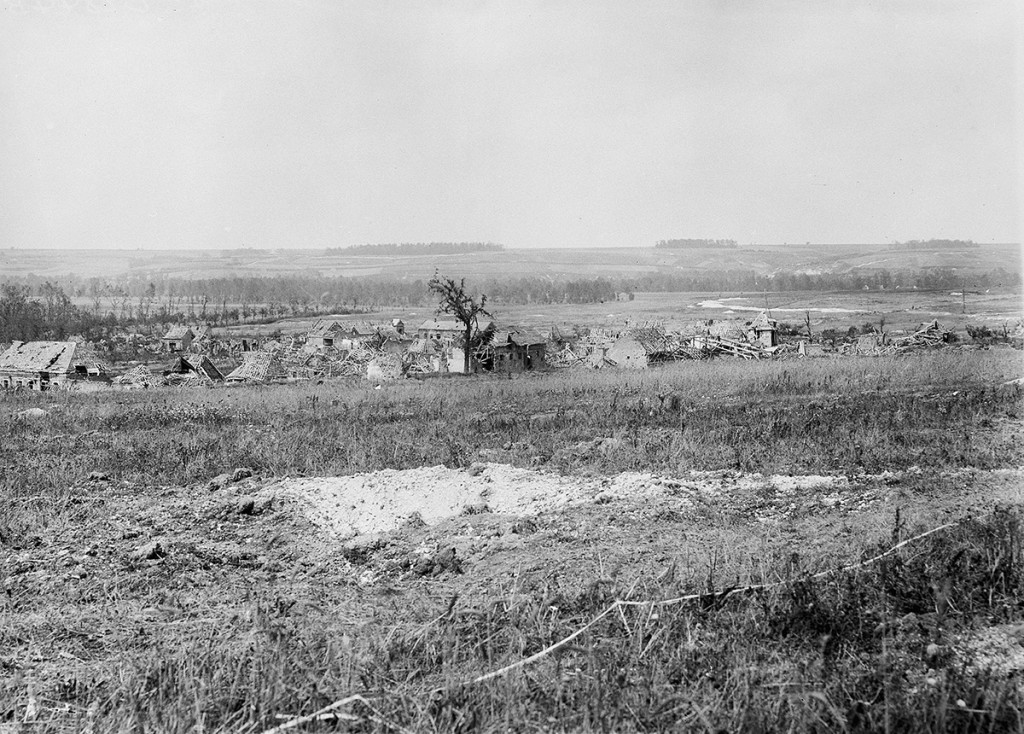 Hamel after the battle (AWM E02844B)
Hamel after the battle (AWM E02844B)
There is in the book, however, impressive and welcome detail on the US contribution, including the composition and command of the 131st and 132nd Regiments that supported the Australian infantry. This information goes further than what is offered even by Charles Bean in the Official History, and gives the reader a greater understanding of US attitudes toward the battle and of the characters that joined the Australians in the line.
On the other hand, Dando-Collins’ sections that discuss his relative Sergeant Ned Searle (imported from the author’s Crack Hardy) detract from the book’s disciplined and mostly factual account. Then, there are parts of the account of Henry Dalziel’s Victoria Cross that differ from that in Wigmore’s classic They Dared Mightily. Dando-Collins has Dalziel pushing beyond the final objective, as well as a different explanation of how Dalziel received his serious head wound. This review is not claiming one or other account is wrong, but Dando-Collins’ new version needs careful consideration by readers.
Of greater concern to specialists, no clear description is provided of the action that led to American Thomas Pope’s Medal of Honor, the first such award of the war. Pope is recorded in Heroes of Hamel (pp. 188-89) as repelling a German counterattack on the evening of 4 July, but the official Medal of Honor citation has him advancing behind tanks, then rushing and capturing an enemy machine gun nest, using it to hold off the enemy until reinforced.
The last fifth of the Dando-Collins’ book goes beyond Hamel to cover Amiens and the operations of the Allied ‘Hundred Days’ offensive (from Amiens to the Armistice). This is an unnecessary addition and Dando-Collins gets key details of the Australian advance wrong. Dando-Collins’ focus on Hamel deserves credit, but the sections covering the Hundred Days detract rather than strengthen the whole.
Both books acknowledge the Australian Corps’ place within the British Expeditionary Force, but then write about Hamel as if Monash operated independently of the BEF for the Hamel attack. While the attack was derived and executed under Australian command, it drew upon British artillery, aircraft and tanks, as well as the comprehensive, vast and professional British logistic network. Both books mostly downplay the British contribution to emphasise that Hamel was an Australian infantry attack under Australian command. One can only hope that readers of both books prefer their prejudices unchallenged.
Monash’s Masterpiece does not educate as much as it could and should, considering the size of FitzSimons’ readership. His writing resonates with a large audience and he has a proven ability to tell gripping stories with drama, pathos, intrigue and excitement. In doing so, however, he dispenses with the fundamentals of historical accuracy and evidence-gathering. Form overrides function; it is effective drama but it is not honest history.
Monash’s Masterpiece is too beset with parochial colloquialisms and hyperbolic prose to have much historical value. It neither asks difficult questions nor investigates why events turned out the way they did, seeking only to interpret the evidence according to pre-conceived agendas, instead of following where the evidence leads.
Speaking of evidence, maps are essential in military history books. Unforgivably, there is no map in Dando-Collins, so readers are unable to follow the specific objectives for the Hamel battle. FitzSimons’ maps are basic but functional, if not absolutely accurate.
Heroes of Hamel is an improvement on FitzSimons, but comes with factual errors and uncritical acceptance of the growing myth around Hamel. It is certainly the easier book to read and does an acceptable job in sketching out the main elements of the planning and execution of Hamel. However, Bean’s Official History (Volume 6) and Pedersen’s shorter book Hamel: Somme (2003) are more authoritative than either book and do not bother with unreferenced value-judgements.
Hamel was a small battle that achieved its objectives effectively while trialling the combined arms elements used with devastating effect at Amiens. Unlike FitzSimons and Dando-Collins, Bean and Pedersen made no claims that Hamel changed either modern warfare or the world. Which is good, because it did neither.
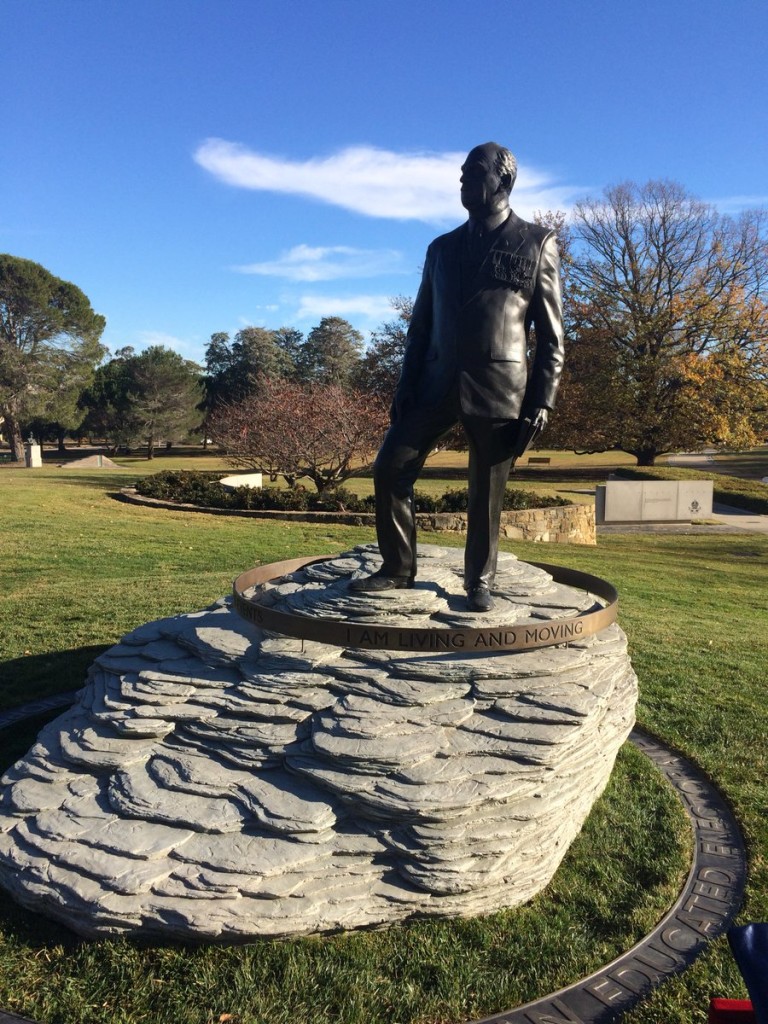 Monash statue unveiled at the Australian War Memorial, 4 July 2018 (Charles Robb and Sarah Holland-Batt, Billmans Foundry; Twitter/Tom Sear). AWM media release.
Monash statue unveiled at the Australian War Memorial, 4 July 2018 (Charles Robb and Sarah Holland-Batt, Billmans Foundry; Twitter/Tom Sear). AWM media release.
Notes
[1] Andrew Richardson has been an historian at the Australian Army History Unit for 11 years. Most of his work has been for internal Army and Defence use, though he is working on a book for the Army on the Battle of Hamel. A recent paper by Dr Richardson on Hamel, including illustrations and maps. The views in the above review are his own and do not necessarily reflect that of the History Unit, the Army or the Department of Defence.
[2] Meleah Hampton, Attack on the Somme: 1st ANZAC Corps and the Battle of Pozières Ridge, 1916, Helion, Warwick, UK, 2016, p. 32.
[3] Peter Stanley, Bad Characters: Sex, Crime, Mutiny, Murder and the Australian Imperial Force, Pier 9, Sydney, 2010, pp. 209-11.